The War of Roses. Tudor England. Reformation Tudor




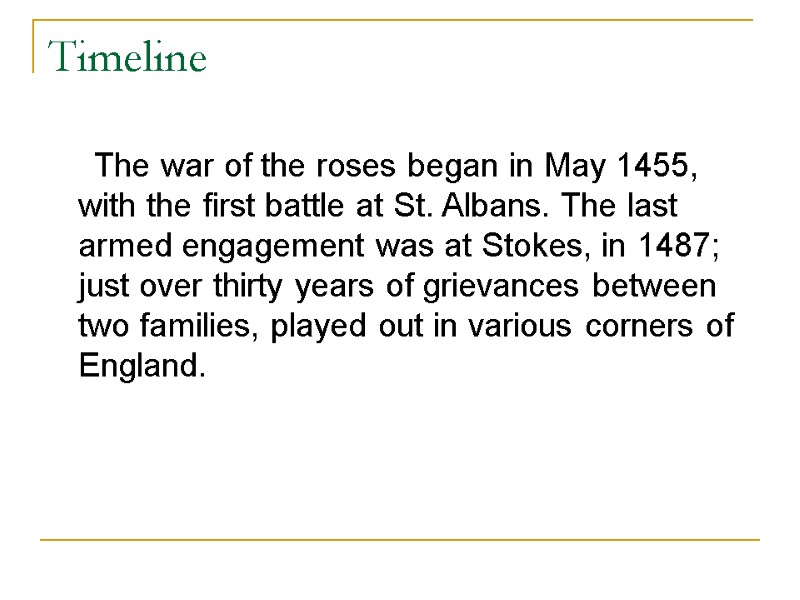

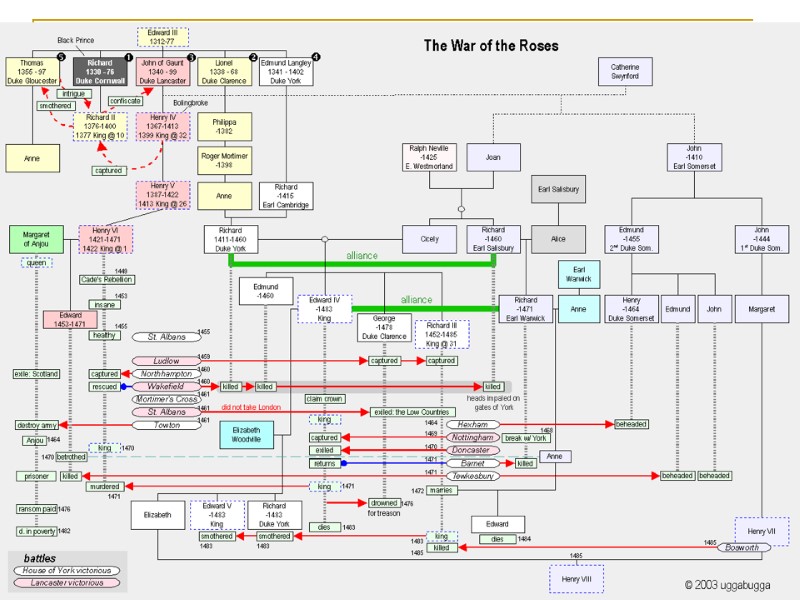










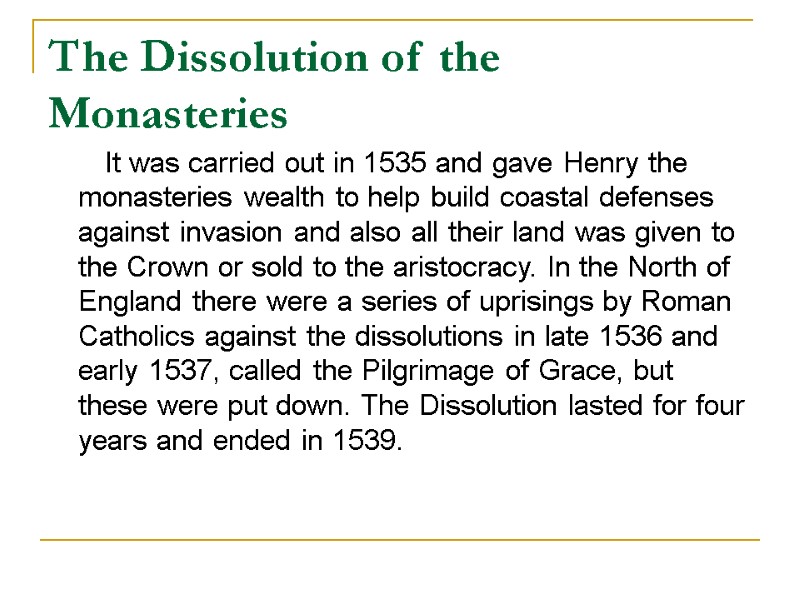



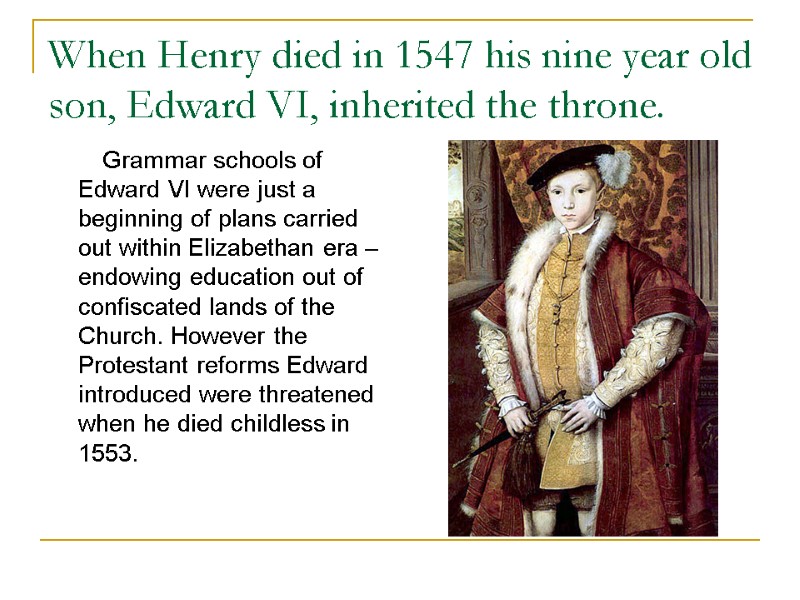

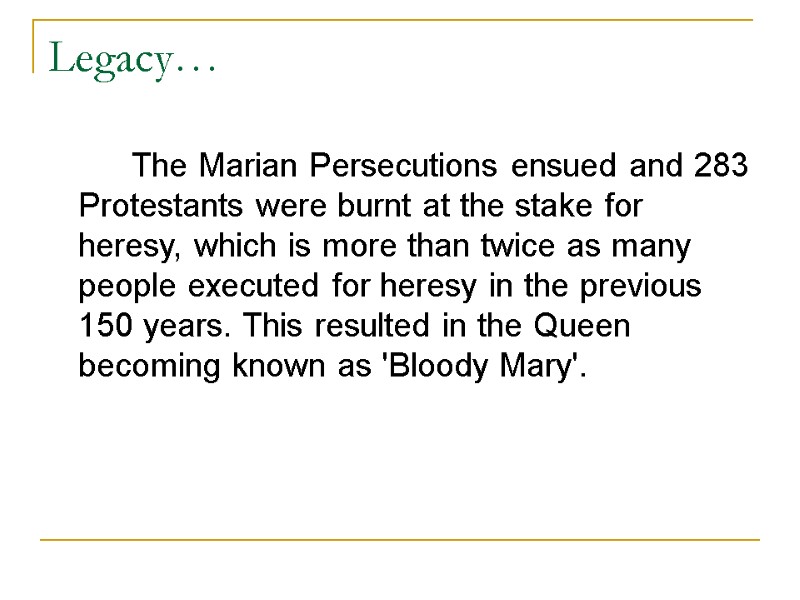












10844-the_war_of_roses.ppt
- Количество слайдов: 35
 The War of Roses. Tudor England. Reformation Tudor accession was preceded by 30 years of feudal struggle and bloodshed, known as the Wars of the Roses. The period had considerably weakened economically and politically the old baronial families. Thus Henry Tudor formed a new monarchy which was based upon a new relationship in society.
The War of Roses. Tudor England. Reformation Tudor accession was preceded by 30 years of feudal struggle and bloodshed, known as the Wars of the Roses. The period had considerably weakened economically and politically the old baronial families. Thus Henry Tudor formed a new monarchy which was based upon a new relationship in society.
 The War of Roses How did this war receive such a pretty name? The title "War of the Roses" is believed to have been first coined by Sir Walter Scott, almost 450 years after Henry VII defeated Richard III.
The War of Roses How did this war receive such a pretty name? The title "War of the Roses" is believed to have been first coined by Sir Walter Scott, almost 450 years after Henry VII defeated Richard III.
 Tudor Rose As for the roses themselves, the White Rose of York and the Red Rose of Lancaster were fixed in the public's mind by Shakespeare. They were referred to in his play "Henry VI"
Tudor Rose As for the roses themselves, the White Rose of York and the Red Rose of Lancaster were fixed in the public's mind by Shakespeare. They were referred to in his play "Henry VI"
 Timeline The war of the roses began in May 1455, with the first battle at St. Albans. The last armed engagement was at Stokes, in 1487; just over thirty years of grievances between two families, played out in various corners of England.
Timeline The war of the roses began in May 1455, with the first battle at St. Albans. The last armed engagement was at Stokes, in 1487; just over thirty years of grievances between two families, played out in various corners of England.
 Character of Conflict Although the confrontations were bloody and vicious, the general population of England wasn't dragged into taking sides. Two families who had pride to uphold, feuds to take care of, and grievances to repair were the only combatants in a war for superiority, with the ultimate prize being the Throne of England.
Character of Conflict Although the confrontations were bloody and vicious, the general population of England wasn't dragged into taking sides. Two families who had pride to uphold, feuds to take care of, and grievances to repair were the only combatants in a war for superiority, with the ultimate prize being the Throne of England.

 Clan Strife From St. Albans in 1455 (where Somerset met his death) to Wakefield in 1460 (where Richard, Duke of York was killed), it was cousin against cousin, supporter against supporter, sometimes brother against brother. Treachery and betrayal were the order of the day, neither side truly winning the war.
Clan Strife From St. Albans in 1455 (where Somerset met his death) to Wakefield in 1460 (where Richard, Duke of York was killed), it was cousin against cousin, supporter against supporter, sometimes brother against brother. Treachery and betrayal were the order of the day, neither side truly winning the war.
 New Epoch born With Richard III's death during the battle, and with Henry's marriage to Edward IV's oldest daughter, Elizabeth, the Houses of York and Lancaster were finally united.
New Epoch born With Richard III's death during the battle, and with Henry's marriage to Edward IV's oldest daughter, Elizabeth, the Houses of York and Lancaster were finally united.
 Henry VII Henry consolidated his position by executing all other possible claimants whenever he could lay hands on them, a policy his son Henry VIII continued. The new Tudor monarchy was absolute: it was supported by the new nobility and the emerging bourgeoisie, who feared the resumption of feudal wars and anarchy. Henry created social groups, directly dependent upon the Crown. He secured favorable terms for English merchants. Even his council rarely came of hereditary nobility: Richard Fox –Chief Minister, had been a schoolmaster; Edmund Dudley – the undersheriff of London; John Stile, who invented the first diplomatic cipher and was appointed ambassador to Spain – began as a grocer
Henry VII Henry consolidated his position by executing all other possible claimants whenever he could lay hands on them, a policy his son Henry VIII continued. The new Tudor monarchy was absolute: it was supported by the new nobility and the emerging bourgeoisie, who feared the resumption of feudal wars and anarchy. Henry created social groups, directly dependent upon the Crown. He secured favorable terms for English merchants. Even his council rarely came of hereditary nobility: Richard Fox –Chief Minister, had been a schoolmaster; Edmund Dudley – the undersheriff of London; John Stile, who invented the first diplomatic cipher and was appointed ambassador to Spain – began as a grocer
 Henry VII
Henry VII
 Enclosures The Tudor period is marked by the rise of clothing industry – which lead to enforced removal of peasants from their lands – known as Enclosures (common village pasture lands were enclosed for the rearing of the landowner’s sheep). In some counties 1/3 of arable land was turned to pastures. There followed one of the worst economic crises that England ever endured – pauperization of peasantry, social anarchy, but also accumulation of free capital, which made traders interested in colonial expansion. Slave trade brought enormous profits to the traders and the Crown.
Enclosures The Tudor period is marked by the rise of clothing industry – which lead to enforced removal of peasants from their lands – known as Enclosures (common village pasture lands were enclosed for the rearing of the landowner’s sheep). In some counties 1/3 of arable land was turned to pastures. There followed one of the worst economic crises that England ever endured – pauperization of peasantry, social anarchy, but also accumulation of free capital, which made traders interested in colonial expansion. Slave trade brought enormous profits to the traders and the Crown.
 Henry VIII (28 June 1491 - 28 January 1547) He was King of England and Lord of Ireland (later King of Ireland) from 22 April 1509 until his death. He is famous for having been married six times and for wielding the greatest power than any British monarch. Notable events during his reign included the break with Rome and the subsequent establishment of the independent Church of England, the Dissolution of the Monasteries, and the union of England and Wales.
Henry VIII (28 June 1491 - 28 January 1547) He was King of England and Lord of Ireland (later King of Ireland) from 22 April 1509 until his death. He is famous for having been married six times and for wielding the greatest power than any British monarch. Notable events during his reign included the break with Rome and the subsequent establishment of the independent Church of England, the Dissolution of the Monasteries, and the union of England and Wales.
 Personality… Henry VIII's accession was the first peaceful one England had witnessed in many years; however, the new Tudor dynasty's legitimacy could yet be tested. The English people seemed distrustful of female rulers, and Henry felt that only a male heir could secure the throne.
Personality… Henry VIII's accession was the first peaceful one England had witnessed in many years; however, the new Tudor dynasty's legitimacy could yet be tested. The English people seemed distrustful of female rulers, and Henry felt that only a male heir could secure the throne.
 Pursuits… Henry VIII is known to have been an avid gambler and dice player. He excelled at sport, especially royal tennis, during his youth. He was also an accomplished musician, author, and poet; according to legend, he wrote the popular folk song Green sleeves
Pursuits… Henry VIII is known to have been an avid gambler and dice player. He excelled at sport, especially royal tennis, during his youth. He was also an accomplished musician, author, and poet; according to legend, he wrote the popular folk song Green sleeves
 The Six Wives of King Henry VIII Catherine of Aragon Anne Boleyn Jane Seymour Anne of Cleaves Catherine Howard Catherine Parr A mnemonic for the fates of Henry's wives is "divorced, beheaded, died, divorced, beheaded, survived".
The Six Wives of King Henry VIII Catherine of Aragon Anne Boleyn Jane Seymour Anne of Cleaves Catherine Howard Catherine Parr A mnemonic for the fates of Henry's wives is "divorced, beheaded, died, divorced, beheaded, survived".
 "The King's Great Matter" Henry's long and arduous attempt to end his marriage to Queen Catherine finally brought about the break with Rome. The English Reformation was the process whereby the external authority of the Roman Catholic Church in England was abolished and replaced with Royal Supremacy and the establishment of a Church of England outside the Roman Catholic Church and under the Supreme Governance of the English monarch. The English Reformation differed from its other European counterparts in that it was more of a political than a theological dispute which was at the root of it. Sometimes it is called the Henrician Reformation.
"The King's Great Matter" Henry's long and arduous attempt to end his marriage to Queen Catherine finally brought about the break with Rome. The English Reformation was the process whereby the external authority of the Roman Catholic Church in England was abolished and replaced with Royal Supremacy and the establishment of a Church of England outside the Roman Catholic Church and under the Supreme Governance of the English monarch. The English Reformation differed from its other European counterparts in that it was more of a political than a theological dispute which was at the root of it. Sometimes it is called the Henrician Reformation.
 The Dissolution of the Monasteries It was carried out in 1535 and gave Henry the monasteries wealth to help build coastal defenses against invasion and also all their land was given to the Crown or sold to the aristocracy. In the North of England there were a series of uprisings by Roman Catholics against the dissolutions in late 1536 and early 1537, called the Pilgrimage of Grace, but these were put down. The Dissolution lasted for four years and ended in 1539.
The Dissolution of the Monasteries It was carried out in 1535 and gave Henry the monasteries wealth to help build coastal defenses against invasion and also all their land was given to the Crown or sold to the aristocracy. In the North of England there were a series of uprisings by Roman Catholics against the dissolutions in late 1536 and early 1537, called the Pilgrimage of Grace, but these were put down. The Dissolution lasted for four years and ended in 1539.
 Bringing God closer to People… In 1539 Parliament passed the Six Articles reaffirming Catholic practices such as transubstantiation, clerical celibacy and the importance of confession to a priest and proscribed penalties if anyone denied them. In the same year Henry authorized the publication of the Great Bible in English. This Bible was largely made through the use of William Tyndale's English translation of the Hebrew and Greek Scripture's. The Bible was used in all Anglican churches and was free to be read
Bringing God closer to People… In 1539 Parliament passed the Six Articles reaffirming Catholic practices such as transubstantiation, clerical celibacy and the importance of confession to a priest and proscribed penalties if anyone denied them. In the same year Henry authorized the publication of the Great Bible in English. This Bible was largely made through the use of William Tyndale's English translation of the Hebrew and Greek Scripture's. The Bible was used in all Anglican churches and was free to be read
 Shipbuilding Along with Alfred the Great, Henry is traditionally called one of the founders of the Royal Navy. There are good reasons for this - his reign featured some naval warfare and, more significantly, large royal investment in shipbuilding (including a few spectacular 'great ships' such as the Mary Rose), dockyards (such as HMNB Portsmouth) and naval innovations (e.g. the use of cannon onboard ship). In the formal sense, however, the modern British navy, the Royal Navy, is largely a product of the naval side of the Napoleonic wars).
Shipbuilding Along with Alfred the Great, Henry is traditionally called one of the founders of the Royal Navy. There are good reasons for this - his reign featured some naval warfare and, more significantly, large royal investment in shipbuilding (including a few spectacular 'great ships' such as the Mary Rose), dockyards (such as HMNB Portsmouth) and naval innovations (e.g. the use of cannon onboard ship). In the formal sense, however, the modern British navy, the Royal Navy, is largely a product of the naval side of the Napoleonic wars).
 Bequest… In modern times, Henry VIII has become one of the most popular historical kings of the English monarchy. This is mainly based on the common perception of his larger than life character as an over-eating, womanizing bon vivant, which in turn is based on somewhat exaggerated stories of his life. In 2002, Henry VIII placed 40th in a BBC-sponsored poll on the 100 Greatest Britons. Henry VIII was the subject of William Shakespeare's historical play, Henry VIII: All Is True, written once it was safe to do so (once his daughter Elizabeth I had died).
Bequest… In modern times, Henry VIII has become one of the most popular historical kings of the English monarchy. This is mainly based on the common perception of his larger than life character as an over-eating, womanizing bon vivant, which in turn is based on somewhat exaggerated stories of his life. In 2002, Henry VIII placed 40th in a BBC-sponsored poll on the 100 Greatest Britons. Henry VIII was the subject of William Shakespeare's historical play, Henry VIII: All Is True, written once it was safe to do so (once his daughter Elizabeth I had died).
 When Henry died in 1547 his nine year old son, Edward VI, inherited the throne. Grammar schools of Edward VI were just a beginning of plans carried out within Elizabethan era – endowing education out of confiscated lands of the Church. However the Protestant reforms Edward introduced were threatened when he died childless in 1553.
When Henry died in 1547 his nine year old son, Edward VI, inherited the throne. Grammar schools of Edward VI were just a beginning of plans carried out within Elizabethan era – endowing education out of confiscated lands of the Church. However the Protestant reforms Edward introduced were threatened when he died childless in 1553.
 Queen Mary From 1553, under the reign of Henry's Roman Catholic daughter, Mary I, the Reformation legislation was repealed and England once again was turned into a Roman Catholic state. Mary's first Act of Parliament was to retroactively validate Henry's marriage to her mother and so legitimize her claim to the throne. On the advice of the Holy Roman Emperor she married his son, Phillip II of Spain
Queen Mary From 1553, under the reign of Henry's Roman Catholic daughter, Mary I, the Reformation legislation was repealed and England once again was turned into a Roman Catholic state. Mary's first Act of Parliament was to retroactively validate Henry's marriage to her mother and so legitimize her claim to the throne. On the advice of the Holy Roman Emperor she married his son, Phillip II of Spain
 Legacy… The Marian Persecutions ensued and 283 Protestants were burnt at the stake for heresy, which is more than twice as many people executed for heresy in the previous 150 years. This resulted in the Queen becoming known as 'Bloody Mary'.
Legacy… The Marian Persecutions ensued and 283 Protestants were burnt at the stake for heresy, which is more than twice as many people executed for heresy in the previous 150 years. This resulted in the Queen becoming known as 'Bloody Mary'.
 Elizabeth I When Mary died childless in 1558 Elizabeth inherited the throne and sought to settle the religious turmoil the country had been through. Elizabeth I was Queen of England and Queen of Ireland until 1603. Sometimes referred to as The Virgin Queen (since she was never married), Gloriana, or Good Queen Bess, Elizabeth I was the fifth and final monarch of the Tudor dynasty.
Elizabeth I When Mary died childless in 1558 Elizabeth inherited the throne and sought to settle the religious turmoil the country had been through. Elizabeth I was Queen of England and Queen of Ireland until 1603. Sometimes referred to as The Virgin Queen (since she was never married), Gloriana, or Good Queen Bess, Elizabeth I was the fifth and final monarch of the Tudor dynasty.
 Elizabethan Era Elizabeth's reign is referred to as the Elizabethan era or the Golden Age and was marked by increases in English power and influence worldwide. Playwrights William Shakespeare, Christopher Marlowe, and Ben Johnson all flourished during this era. Her reign coincides in fact with the peak of Renaissance in England.
Elizabethan Era Elizabeth's reign is referred to as the Elizabethan era or the Golden Age and was marked by increases in English power and influence worldwide. Playwrights William Shakespeare, Christopher Marlowe, and Ben Johnson all flourished during this era. Her reign coincides in fact with the peak of Renaissance in England.
 Theatre in Shakespeare’s Times
Theatre in Shakespeare’s Times
 Changes in the Language The peak of Renaissance in England, which brought about considerable changes in the language, making it sound close to what we are used to: one marked feature was heavy Latinate and Greek borrowings (which lead to a sizable stock of words of ‘false’ etymology, like isle – island, could – should, would; or repeated assimilations from Latin – etymological doublets: sure- secure, blame – blaspheme, frail - fragile. The process had been so active that some purists of the time started protesting against ‘spoiling the mother tongue’).
Changes in the Language The peak of Renaissance in England, which brought about considerable changes in the language, making it sound close to what we are used to: one marked feature was heavy Latinate and Greek borrowings (which lead to a sizable stock of words of ‘false’ etymology, like isle – island, could – should, would; or repeated assimilations from Latin – etymological doublets: sure- secure, blame – blaspheme, frail - fragile. The process had been so active that some purists of the time started protesting against ‘spoiling the mother tongue’).
 Era of Geographic Discoveries Started… Francis Drake became the first Englishman to circumnavigate the globe; Francis Bacon laid out his philosophical and political views; and English colonization of North America took place under Sir Walter Raleigh and Sir Humphrey Gilbert. Virginia, an English colony in North America and afterwards a member of the United States, was named after Elizabeth I, the "Virgin Queen".
Era of Geographic Discoveries Started… Francis Drake became the first Englishman to circumnavigate the globe; Francis Bacon laid out his philosophical and political views; and English colonization of North America took place under Sir Walter Raleigh and Sir Humphrey Gilbert. Virginia, an English colony in North America and afterwards a member of the United States, was named after Elizabeth I, the "Virgin Queen".
 Drake’s Strait
Drake’s Strait
 War with Spain After the assassination of the Dutch Stadholder William I, England began to side openly with the United Provinces of the Netherlands, who were at the time rebelling against Spanish rule. This, together with economic conflict with Spain and English piracy against Spanish colonies (which included an English alliance with Islamic Morocco), led to the outbreak of the Anglo-Spanish War in 1585 and in 1586 the Spanish ambassador was expelled from England for his participation in conspiracies against Elizabeth.
War with Spain After the assassination of the Dutch Stadholder William I, England began to side openly with the United Provinces of the Netherlands, who were at the time rebelling against Spanish rule. This, together with economic conflict with Spain and English piracy against Spanish colonies (which included an English alliance with Islamic Morocco), led to the outbreak of the Anglo-Spanish War in 1585 and in 1586 the Spanish ambassador was expelled from England for his participation in conspiracies against Elizabeth.
 Beginning… In her will, Mary had left Philip her claim to the English Throne; under force of the threat from Elizabeth's policies in the Netherlands and the east Atlantic, Philip set out his plans for an invasion of England. In April 1587, Sir Francis Drake burned part of the Spanish fleet at Cadiz, delaying Philip's plans. In July 1588, the Spanish Armada, a grand fleet of 130 ships bearing over 30,000 men, set sail in the expectation of conveying a Spanish invasion force under the command of the Duke of Parma across the English Channel from the Netherlands. Elizabeth encouraged her troops with a notable speech, known as the Speech to the Troops at Tilbury, in which she famously declared, "I know I have the body but of a weak and feeble woman; but I have the heart and stomach of a King, and of a King of England too".
Beginning… In her will, Mary had left Philip her claim to the English Throne; under force of the threat from Elizabeth's policies in the Netherlands and the east Atlantic, Philip set out his plans for an invasion of England. In April 1587, Sir Francis Drake burned part of the Spanish fleet at Cadiz, delaying Philip's plans. In July 1588, the Spanish Armada, a grand fleet of 130 ships bearing over 30,000 men, set sail in the expectation of conveying a Spanish invasion force under the command of the Duke of Parma across the English Channel from the Netherlands. Elizabeth encouraged her troops with a notable speech, known as the Speech to the Troops at Tilbury, in which she famously declared, "I know I have the body but of a weak and feeble woman; but I have the heart and stomach of a King, and of a King of England too".
 Outcome… The Spanish attempt was defeated by the English fleet under Charles Howard, 2nd Baron Howard of Effingham and Sir Francis Drake, aided by bad weather. (The memorial medal reads: Afflavit Deus et dissipantur –Господь дунул и они рассеялись) The Armada was forced to return to Spain, with appalling losses on the north and west coasts of Ireland; the victory tremendously increased Elizabeth's popularity.
Outcome… The Spanish attempt was defeated by the English fleet under Charles Howard, 2nd Baron Howard of Effingham and Sir Francis Drake, aided by bad weather. (The memorial medal reads: Afflavit Deus et dissipantur –Господь дунул и они рассеялись) The Armada was forced to return to Spain, with appalling losses on the north and west coasts of Ireland; the victory tremendously increased Elizabeth's popularity.
 Cultural Significance Elizabeth proved to be one of the most popular monarchs in English or British history. She placed seventh in the 100 Greatest Britons poll, which was conducted by the British Broadcasting Corporation in 2002, outranking all other British monarchs. In 2005, in the History Channel documentary Britain's Greatest Monarch, a group of historians and commentators analyzed twelve British monarchs and gave them overall marks out of 60 for greatness (they were marked out of 10 in six categories, such as military prowess and legacy). Elizabeth I was the winner, with 48 points.
Cultural Significance Elizabeth proved to be one of the most popular monarchs in English or British history. She placed seventh in the 100 Greatest Britons poll, which was conducted by the British Broadcasting Corporation in 2002, outranking all other British monarchs. In 2005, in the History Channel documentary Britain's Greatest Monarch, a group of historians and commentators analyzed twelve British monarchs and gave them overall marks out of 60 for greatness (they were marked out of 10 in six categories, such as military prowess and legacy). Elizabeth I was the winner, with 48 points.
 Tudor House
Tudor House
 As a whole the historical period may be regarded as a prelude to the bourgeois revolution of the 17th century. This was reflected in all spheres of life and human thought Thank you for your attention!
As a whole the historical period may be regarded as a prelude to the bourgeois revolution of the 17th century. This was reflected in all spheres of life and human thought Thank you for your attention!

